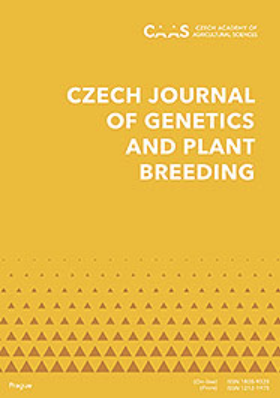利用SSR标记验证常见葡萄种间品种的抗性位点金字塔化
IF 1.8
4区 农林科学
Q3 AGRONOMY
引用次数: 0
摘要
真菌病原体葡萄浆原菌(Plasmopara viticola)。& M.A.柯蒂斯)伯尔。& De Toni(霜霉病)和Erysiphe necator Schwein。白粉病是全球葡萄种植者面临的最大威胁。在适当的条件下,这些病原体可以在葡萄园中迅速传播并造成重大损害。最生态的方式toÂ降低ofÂ感染的可能性inÂ葡萄园isÂ种植种间基因型,能够toÂ抑制这些病原体并阻止传播ofÂ感染。基于这种inÂ思路,对9个国际葡萄基因型和11个捷克葡萄基因型进行了分析inÂ顺序为toÂ,对它们所存在的抗性位点进行了基因型分析inÂ。As aÂ工具a set of SSR标记链接toÂ已知位点ofÂ抗性toÂ使用霜霉病和白粉病。分别用SSR标记分析了of 4个负责抗性的位点toÂ葡萄浆原体(Rpv3、Rpv4、Rpv7和Rpv10)和2个负责抗性的位点(Ren3和Ren9)的存在。ByÂ由此对ofÂ抗性基因金字塔化程度进行了新的评价inÂ对所有分析品种及其选育前景进行了讨论inÂ。本文章由计算机程序翻译,如有差异,请以英文原文为准。
Verification of resistance loci pyramiding in popular interspecific grape varieties using SSR markers
Fungal pathogens Plasmopara viticola (Berk. & M.A. Curtis) Berl. & De Toni (downy mildew) and Erysiphe necator Schwein. (powdery mildew) represent the biggest threats for grape growers worldwide. Under suitable conditions, these pathogens can spread very quickly through vineyards and cause significant damage. The most ecological way to reduce the possibility of infection in vineyards is growing interspecific genotypes which are able to suppress these pathogens and stop the spread of infection. With this in mind, 9 international and 11 Czech grapevine genotypes were analysed in order to genotype the resistance loci present in them. As a tool a set of SSR markers linked to known loci of resistance to downy and powdery mildew was used. Namely, presence of four loci responsible for resistance to Plasmopara viticola (Rpv3, Rpv4, Rpv7, and Rpv10) and two for Erysiphe necator (Ren3 and Ren9) loci were analysed with respective SSR markers. By this way the degree of resistance gene pyramiding was newly assessed in all analysed cultivars and their perspectives in grapevine breeding are discussed.
求助全文
通过发布文献求助,成功后即可免费获取论文全文。
去求助
来源期刊

Czech Journal of Genetics and Plant Breeding
Agricultural and Biological Sciences-Plant Science
CiteScore
2.20
自引率
0.00%
发文量
25
审稿时长
>12 weeks
期刊介绍:
Original scientific papers, critical reviews articles and short communications from the field of theoretical and applied plant genetics, plant biotechnology and plant breeding. Papers are published in English.
 求助内容:
求助内容: 应助结果提醒方式:
应助结果提醒方式:


